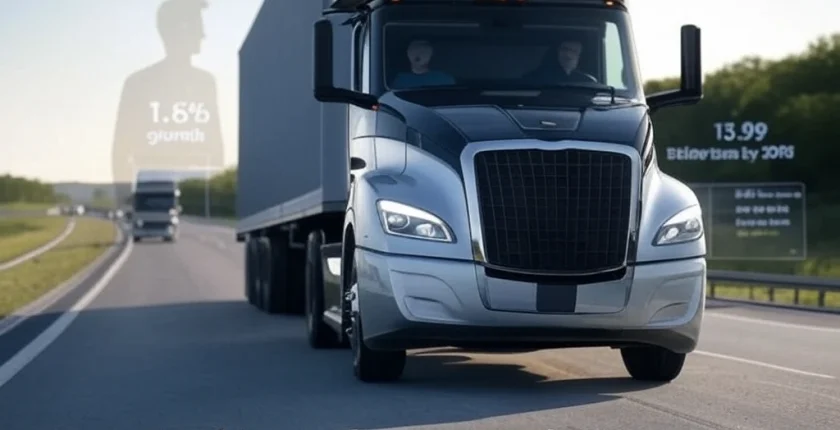Trucking Industry Trends in 2025: Predictions and Insights for the Future
The U.S. trucking industry in 2025 stands at a crossroads of opportunity and challenge. As the backbone of American commerce, moving nearly three-quarters of the nation’s freight, this sector is poised for transformation driven by economic recovery, technological innovation, and sustainability demands. With freight volumes projected to grow by 1.6% in 2025 and electric trucks expected to hit 54,000 on U.S. roads, the industry is adapting to a dynamic landscape. This article dives deep into the top trucking industry trends for 2025, offering detailed predictions and actionable insights for fleet managers, drivers, and logistics professionals.
A Rebounding Market: Freight Volumes and Economic Growth
After two years of declines, the trucking industry is set for a modest rebound in 2025. Industry forecasts predict a 1.6% increase in truck volumes, fueled by stabilizing supply chains and a growing U.S. economy at a projected 2.0% year-over-year rate. This growth, while tempered by high borrowing costs and cautious consumer spending, signals a shift from the freight recession of recent years. Long-term projections are even more promising, with truck tonnage expected to climb from 11.27 billion tons in 2024 to 13.99 billion tons by 2035, and revenues soaring to $1.46 trillion.
For trucking companies, this means preparing for increased demand while navigating overcapacity challenges. Analysts suggest that strategic fleet management and route optimization will be key to capitalizing on this uptick. Curious about how this growth could impact your operations? Keep reading to explore the factors shaping this trend.
The Persistent Driver Shortage: A Workforce in Flux
One of the most pressing trucking industry trends in 2025 is the ongoing driver shortage. By late 2024, the shortfall is estimated at 82,000 drivers, a figure likely to persist into 2025 without significant intervention. With an aging workforce and turnover rates exceeding 90% for long-haul drivers, the industry faces a critical challenge. Long-term forecasts warn of a potential 160,000-driver gap by 2028 if trends continue.
To address this, companies are boosting wages, enhancing benefits, and targeting younger, diverse talent. Training programs and improved work-life balance initiatives are also gaining traction. For drivers considering a career shift or fleet owners looking to retain talent, 2025 will be a pivotal year to adapt workforce strategies. How can technology help bridge this gap? Let’s explore.
Technology Takes the Wheel: Automation and Efficiency
Technology is revolutionizing the trucking industry in 2025, with autonomous systems and advanced fleet management tools leading the charge. Autonomous trucking, including features like adaptive cruise control and radar safety systems, is gaining ground, promising enhanced safety and reduced driver fatigue. While fully autonomous fleets may still be years away, semi-autonomous technologies are already improving efficiency.
Transportation management systems (TMS) and AI-driven analytics are also transforming operations. These tools optimize routes, cut fuel costs, and provide real-time insights, helping fleets stay competitive. For trucking businesses, investing in these innovations could mean the difference between thriving and falling behind in 2025. Ready to see how sustainability ties into this tech surge? Keep scrolling.
Sustainability on the Rise: Electric Trucks and Beyond
Sustainability is a defining trend for the trucking industry in 2025, with electric trucks projected to reach 54,000 on U.S. roads—a 27-fold increase from 2019. Driven by regulatory incentives like CARB’s Clean Truck Regulation and growing environmental awareness, this shift is reshaping fleet strategies. Battery technology improvements and expanding charging infrastructure are making electric trucks a viable option, though challenges like upfront costs and infrastructure gaps remain.
Beyond electrification, 60% of fleets using decarbonization tools report reduced emissions, highlighting technology’s role in greener operations. For companies eyeing a sustainable edge, 2025 offers a chance to leverage federal and state incentives for zero-emission vehicles. Wondering how this impacts costs? Let’s break it down.
Economic Pressures and Operational Costs
Rising operational costs continue to squeeze trucking companies in 2025. After a 6.6% cost increase in 2023, fleets face pressures from fuel prices, equipment expenses, and regulatory compliance. The shift to electric and alternative-fuel trucks, while eco-friendly, brings higher upfront costs, prompting many to explore leasing or used equipment options. Predictive maintenance is also extending asset lifespans, offering a cost-saving lifeline.
Freight rates are expected to stabilize as capacity tightens and demand recovers, but businesses must adopt proactive pricing strategies to stay profitable. How can supply chain dynamics amplify these challenges? The next section has the answers.
Supply Chain Evolution: Resilience and Regional Focus
The trucking industry in 2025 is adapting to a more resilient supply chain landscape, shaped by lessons from the COVID-19 era. Companies are diversifying suppliers, refining inventory management, and prioritizing regional transportation to mitigate disruptions. With freight tonnage projected to rise 28% from 2021 to 2032, reaching 19.3 billion tons, trucking remains the linchpin of logistics.
This shift means increased demand for long-distance freight, especially as air and ocean freight grow, underscoring trucking’s role in last-mile delivery. For logistics professionals, leveraging data analytics to predict and mitigate disruptions will be crucial. Want to know what’s next for the industry? Here’s the wrap-up.
Looking Ahead: Opportunities and Challenges in 2025
The trucking industry in 2025 is a blend of promise and complexity. Freight growth offers opportunities for expansion, but driver shortages and rising costs demand innovative solutions. Technology and sustainability are driving efficiency and environmental progress, yet their adoption requires strategic investment. Supply chain resilience ensures stability, but geopolitical and economic variables—like diesel prices and trade policies—could shift the outlook.
For trucking businesses, staying ahead means embracing data-driven decisions, upskilling the workforce, and aligning with regulatory trends. Whether you’re a fleet owner, driver, or logistics manager, now’s the time to plan for a transformative year. How will you navigate these trucking industry trends in 2025? Share your thoughts below or explore our resources for more insights!
